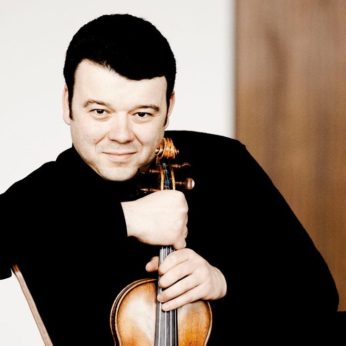Composer: Sergei Prokofiev (b. 1891 - d. 1953)
Performance date: 03/07/2013
Venue: Bantry Library
Composition Year: 1946
Duration: 00:29:16
Recording Engineer: Damian Chennells, RTÉ lyric fm
Instrumentation Category:Duo
Artists:
Vadim Gluzman -
[violin]
Angela Yoffe -
[piano]

Prokofiev established himself as enfant terrible in the second decade of
the last century. His first two piano concertos caused a furore, the second
reputedly left listeners frozen with
fright, hair standing on end. The critics had a field day, scarcely able to
find strong enough terms of condemnation. After the Revolution he lived mainly
in the
gradually settled down. The last seventeen years of his life he spent in the
stimulated but later drastically restricted by Stalin’s cultural policies.
Throughout his life he wrote music for the stage and his compositions always
have a sharp sense of drama, even after he had stopped trying to shock his
audience into paralysis.
The F minor Sonata was begun in 1938, after
his return to
but it took him eight years to finish it. Although known as the First Sonata it
was actually the second to be finished. The first movement has the sombre
atmosphere of a funeral march and Prokofiev himself compared a famous passage
to the wind in a graveyard, a passage
that returns to haunt us at the end of the last movement. Prokofiev is said to
have told his wife that the work was directly inspired by Handel’s D major
Sonata, which certainly explains the typical baroque four-movement plan of
slow-fast-slow-fast. At Prokofiev’s funeral, ironically on the same day as
Stalin’s, David Oistrakh played the two Andantes from this Sonata, the wind in
the graveyard now sounding over the composer’s coffin.
The second movement unleashes demons with
all the ferocity of a Shostakovich; jagged, coruscating chords drive the music
forward with unrelenting savagery, reflecting the terrible times in which they
lived. Despite several attempts to soften the impact, the power of this music
leaves an indelible impression of anger and horror that the composer is quite
unable to mitigate. The second Andante begins gently before developing an
intensely felt lyricism, but towards the end the mood darkens and the music
seems to disintegrate in front of us.
The finale finally lifts us out of the
darkness into something approaching the excitement generated by Prokofiev’s old
role as rule-breaker and innovator. The rhythmic scheme begins to complicate
and the tempo increases, although the episodes make an attempt to slow down the
hectic dance. Once again the end is signalled by the pace slackening and we
meet again the funeral tread and the wind in the graveyard from the first
movement, returning unassuaged until we reach a kind of consolation in the
final bars.
Copyright © 2024 West Cork Music. All rights reserved.
Designed and developed by Matrix Internet